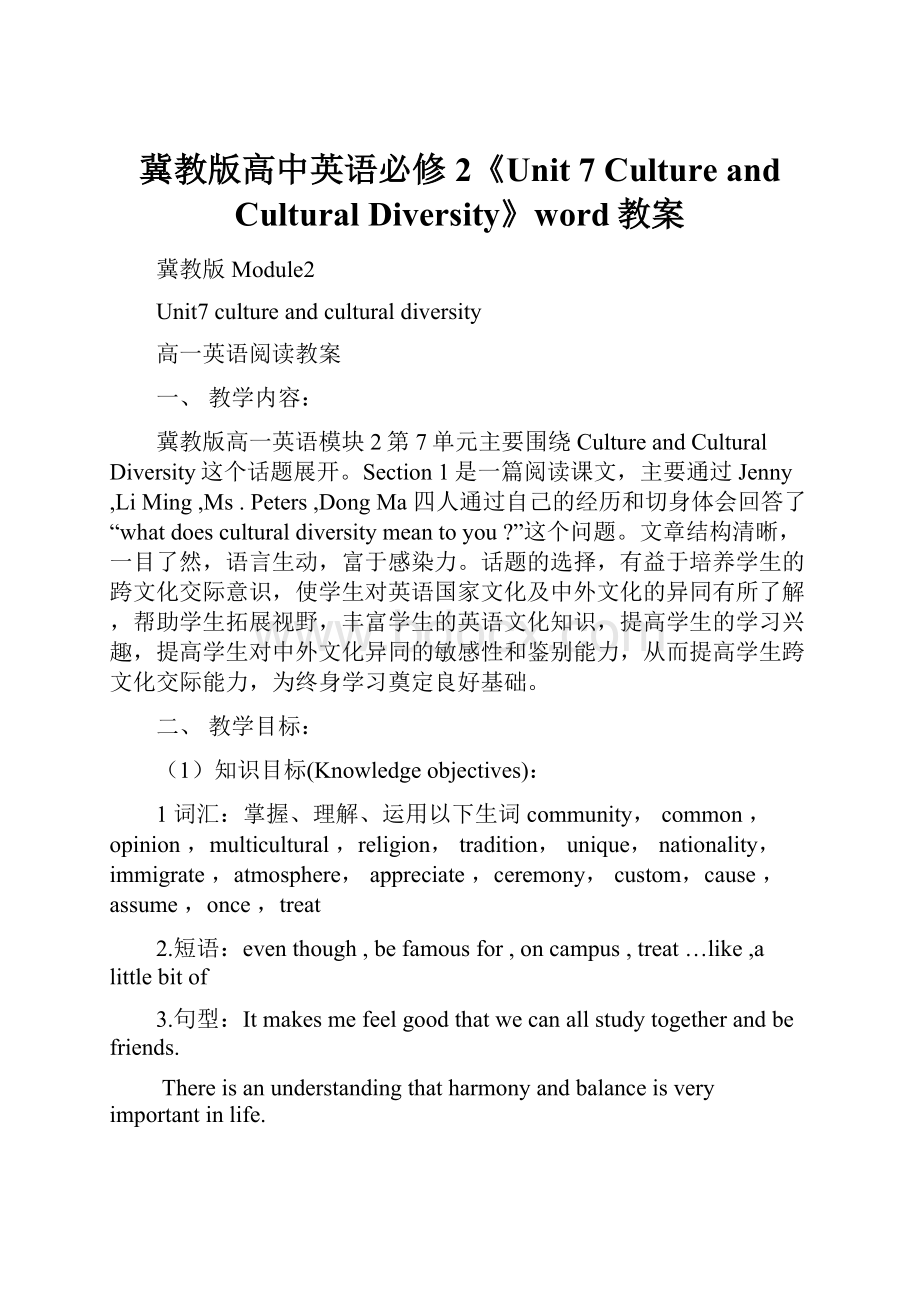冀教版高中英语必修2《Unit 7 Culture and Cultural Diversity》word教案.docx
《冀教版高中英语必修2《Unit 7 Culture and Cultural Diversity》word教案.docx》由会员分享,可在线阅读,更多相关《冀教版高中英语必修2《Unit 7 Culture and Cultural Diversity》word教案.docx(9页珍藏版)》请在冰豆网上搜索。

冀教版高中英语必修2《Unit7CultureandCulturalDiversity》word教案
冀教版Module2
Unit7cultureandculturaldiversity
高一英语阅读教案
一、教学内容:
冀教版高一英语模块2第7单元主要围绕CultureandCulturalDiversity这个话题展开。
Section1是一篇阅读课文,主要通过Jenny,LiMing,Ms.Peters,DongMa四人通过自己的经历和切身体会回答了“whatdoesculturaldiversitymeantoyou?
”这个问题。
文章结构清晰,一目了然,语言生动,富于感染力。
话题的选择,有益于培养学生的跨文化交际意识,使学生对英语国家文化及中外文化的异同有所了解,帮助学生拓展视野,丰富学生的英语文化知识,提高学生的学习兴趣,提高学生对中外文化异同的敏感性和鉴别能力,从而提高学生跨文化交际能力,为终身学习奠定良好基础。
二、教学目标:
(1)知识目标(Knowledgeobjectives):
1词汇:
掌握、理解、运用以下生词community,common,opinion,multicultural,religion,tradition,unique,nationality,immigrate,atmosphere,appreciate,ceremony,custom,cause,assume,once,treat
2.短语:
eventhough,befamousfor,oncampus,treat…like,alittlebitof
3.句型:
Itmakesmefeelgoodthatwecanallstudytogetherandbefriends.
Thereisanunderstandingthatharmonyandbalanceisveryimportantinlife.
Ithinkitisgoodwhenwecanlearnaboutothercustomsandattitudes.
TheytreatedmelikeIwasjustanotherstudent.
(2)能力目标(Abilityobjectives):
1.Helpthestudentshaveabetterunderstandingofthecontentandstructureofthetext
2.Trainthestudents’abilityofreadingcomprehension.
(3)学习策略(Strategyobjectives)
Communicativelearningandcooperativelearning
(4).情感态度(Moralobjectives)
1.Developthestudents’confidenceandcooperationinstudy,
2.Getthestudentstobeinterestedincultureandtrainthestudents’awarenessofculturedifference.
三教学重难点(teachingimportantanddifficultpoints):
1.Createconditionsforstudentstogetrelatedinformationbyscanningandskimming
2.Improvethestudents’abilitytosolveproblems.
3.Trainthestudents’abilityofreadingcomprehension;
4.Strengthenthestudents’culturalawareness
四教法选择(Teachingmethods):
以任务型教学活动为主,兼顾情景和视听教学法。
根据本课特点确定采用这种教法来有效组织课堂教学,这样切实体现了学生的主体地位,能充分调动学生学习的积极性和主动性,并能给学生创造各种语言情景,提供各种运用英语的机会,让学生充分接触英语,运用英语,提高学生听说读写的能力。
同时又能面向全体学生,通过设置任务的难易使不同的学生都有所得,有利于让更多的学生冒尖,同时对学习有困难的又及时给予帮助
五教学过程:
Step1:
Pre-reading(warmingUp)
T:
Goodmorning,everyone.SupposeaforeignercomestoChina,whatwillyouintroducetohimorherwhichcanbestrepresentativeChina?
S(a):
IwillshowhimorheraroundtheGreatWall.
S(b):
Iwillplaygongfuforhim.
S(c):
IwilltakehimtothehometownofConfucius.
S(d):
IwillplayerhuforhimtoenjoythetraditionalChinesemusiccalled
Erquanyingyue.
T:
Summary.Thestudentsdidaverygoodjob.Now,I’dliketoshowyouapicture.Doyouknowwhatitis?
S:
Zhongguojie
T:
DoyouknowhowtosayitinEnglish?
S:
Itiscalled“GoodLuckknot”.
T:
Verygood.Fromthenamewecanseethisknotcanbringus----
S:
Goodluck.
T:
Ifyouseeit,youwillberemindedofourcountry.Youcangiveittoyourforeignfriendasasouvenir.ThatstandsforChinesetraditionalculture.Nowlookatthenextpicture.
T:
Whatcanyouseeinthispicture?
S:
ItisaChristmastreewithalotofgiftsonit.
T:
good.GoodLuckKnotStandsforChineseculture,whileChristmastreestandsfor--
S:
Westernculture.TheculturebetweenEastandWestisdifferent.Iwillshowyoumoreexamples.
T:
Nowlookatthescreen.Trytoguesshowtofillintheblankswithanimalnames
asstrongasa_____(体壮如牛)
asstupidasa_____(蠢笨如猪)
likea____towater(如鱼得水)
astimidasa_____(胆小如鼠)
talk______(吹牛)
(keys:
horse,goose,duck,rabbit,horse)
T:
Fromthisactivity,wecanseethesameanimalhasdifferentimpliedmeaningindifferentcountries.Weliveinaworldofculturaldiversity.WecannotrecreateEnglishidiomsaccordingtoChinesethinking.Ifso,youcanmakeyourselfconfused.
(简评:
通过对比,使学生强烈的感受到中外文化的差异,激发学生进一步学习的热情,然后直接引出话题CultureDiversity。
这样就使导入部分具有“切入口小,切入主题快”的效果。
)
T:
Weliveourlivesaspartofmanycultures.Therearedifferencesamongus,thatistrue.Whatisyourunderstandingofculturediversity?
(Askthestudentstodiscussinpairsfirst,andthenaskseveralpairstoreporttheiranswers.)
1)whatdoesculturaldiversitymeantoyou?
2)Haveyouexperiencedculturaldiversityinyourcommunity?
3)Howwouldyoufeelifyouwerelivinginamulticulturalcommunity?
(简评:
通过讨论,在相互交流中,激发学生说的兴趣,加深对阅读对象背景的了解,并培养其发现问题解决问题的能力,同时也可放松读前的紧张心理。
)
T:
Somuchforthediscussion.Nowlet’splayagame___wordguessing.
(Dividetheclassintotwogroups,boysandgirls.Askeachgrouptochoosetworepresentativestoactoutthisplay.Theyfaceeachother.Onestudentwillusehisownwordstoparaphrasethewordandasktheotherstudenttoguesswhichwordheorsheistalking.Eithergroupwillbegivenoneminute.Thegroupwhichcanguessmorewordswillbethewinner.)
1Planet1immigrate
2Youth2race
3Religion3campus
4Tradition4London
5Custom5Paris
6Hamlet6Summer
7Shakespeare7clock
8Washington8harmony
9Green9lecture
10Air10moon
(简评:
如果让学生自己预习课文的单词后再重复读单词,未免枯燥,而猜词的游戏会极大的调动学生的积极性,又可排除影响学生理解课文的生词障碍。
以上这些热身活动意义在于使学生处于积极的准备状态,带着目的和愿望去读,充满信心去读,变被动式阅读为主动式阅读,这也有助于形成阅读技巧,提高理解能力及英语口头表达能力。
)
Step2:
While-reading(presentation)
TaskOne:
Skimming
T:
Doyouwanttoknowothers’ideasonculturaldiversity?
S:
Yes.
T:
Nowreaditquicklyandtrytofindthekeysentenceofeachshortpassage.
(Askthestudentstoreadthroughthetextandtrytofindthekeysentenceofeachshortpassage.Beforegivingthestudents’theanswers,askthemtodiscussfirst.)
1)passage1Igrewupwithculturaldiversity.
2)Passage2Chinahasitsownuniqueofculturaldiversity.
3)Passage3Ienjoyworkinginthishighschool.
4)Passage4IwassurprisedwhenIarrivedinCanadatostudy.
(简评:
训练学生寻找主题句的技巧,帮助学生从整体上把握文章大意,理清作者写作思路,同时也体现了合作学习的思想.每一段落通常是围绕某一中心展开的,因此,在阅读课教学时要有意识的培养学生找出主题句,抓住中心,使学生理解主题句与文章的具体事实细节的关系,这样坚持做,循序渐进,日积月累,能够有力地培养学生的阅读理解能力,为将来的高考打下基础。
)
TaskTwoListening&Scanning:
Listentothetape,andthentelluswhetherthefollowingstatementsaretrueorfalse.Ifitisfalse,howtocorrectit?
1)Canadaisfamousforitsbeingamulticulturalsociety.
2)Chinahasitsownuniquekindofculturaldiversity.
3)AllthenationalitiesinChinadonotsharemanycommontraditionsandattitudestowardslife.
4)MS.PetersisalibrarianinaSouthAmericanhighschool.
5)DongMaisaChinesestudentinAmerica.
(Keys:
TTFFF)
(简评:
听和读都是获取信息的有效途径。
通过学生边听边读可以培养其快速阅读能力。
通过有目的的听和读,让学生在了解课文大意的同时把握课文中的一些细节内容而且学生能够进一步了解课文的内容.)
TaskThreeCarefulReading
让学生仔细阅读课文,深入理解文章内容,了解细枝抹节并且讲解重点词和句型的用法。
通过仔细阅读课文,让学生回答以下问题:
1)Jennysaysthat“Ihavegrownupwithculturaldiversity”.Whatsupportingdetailsdoesshegivetosupportherstatement?
2)AccordingtoLiming,whatmakestheChinesepeoplethesamebehindobviousculturaldiversity?
3)WhydoyouthinkDongMa’sclassmateswerenotthat“friendlyandhopeful”tohimatthebeginning?
(简评:
创造型任务活动(creativetasks)让学生进一步阅读课文,了解课文内容,寻找关键信息,充分发挥创造性思维,完成难度适中,具有一定挑战性的任务。
.)
Step3.Post-reading(extension)
TaskOne:
Discussion
Howwouldyoufeelifoneofyourteachersworeaturbanorsomeothersymbolofhisculture?
Wouldyoufeelgoodaboutit?
Whyorwhynot?
(简评:
解决问题任务活动(problem-solvingtasks).学生联系课文,结合实际解决问题。
该设计基于课文内容,但又不局限于课文范畴,旨在发散学生的思维,在讨论中引起共鸣,有利于培养跨文化交际能力.)
TaskTwo:
Debate
Situation:
Differentcountryhasdifferentculture.SomestudentsmaythinkChinesecultureisbetterthanAmericanCulture.However,othershaveabeliefthatAmericancultureisbetterthanours.What’syouridea?
(简评:
创造型任务活动(creativetasks).辩论是学生比较喜欢的活动,有利于拓展视野,使学生的学习从维持性学习向自由创新型学习转变,从接受性学习向研究性学习过渡,提高对中外文化异同的敏感性和鉴别力,培养学生客观的评价事物和辨证的看问题的能力。
要尽力创造宽松学生辩论激烈,思维活跃,教学效果较好.)
Step4Homework
1)Writeanarticleabouttheculturaldiversityyoueverexperiencedinyourcommunity.
2)Gotowebsitestofindmoreinformationaboutculturaldiversity.
(简评:
阅读的最高目标是应用。
通过听读的输入,激活和扩展学生说写的输出,这是培养学生综合运用语言进行交际的必要途径,既训练了学生运用英语的能力,又把德育寓于英语教学中。
另外,让学生上网去获取信息,这也有助于培养其自主学习的能力.)
【课后反思】
新一轮英语课改的重点是,从学生的学习兴趣、生活经验和认知水平出发,倡导合作型学习方式和任务型教学,发展学生的综合语言运用能力。
本课的这种整体教学设计符合“任务型教学”的原则,能使学生逐步深入的理解课文,同时训练和提高他们的阅读技能。
本课的任务设计,源于课文,但又高于课文,教师带领学生层层深入,不断启发学生的思维,发挥了调控者和帮助者的角色。
学生主动参与,自己去发现问题、分析问题和解决问题,体现了学生的主体地位,促进了任务的实现。
另外,需要注意教学环节要过渡自然,要有可操作性,让学生在不知不觉中进入状态并开展活动,在设计活动时应充分考虑学生的情感态度,排除学生的心理障碍,帮助学生建立自信心和探索的勇气,营造师生合作,生生合作,平等讨论和自由争辩的气氛,要设法让学生在快乐中学习。